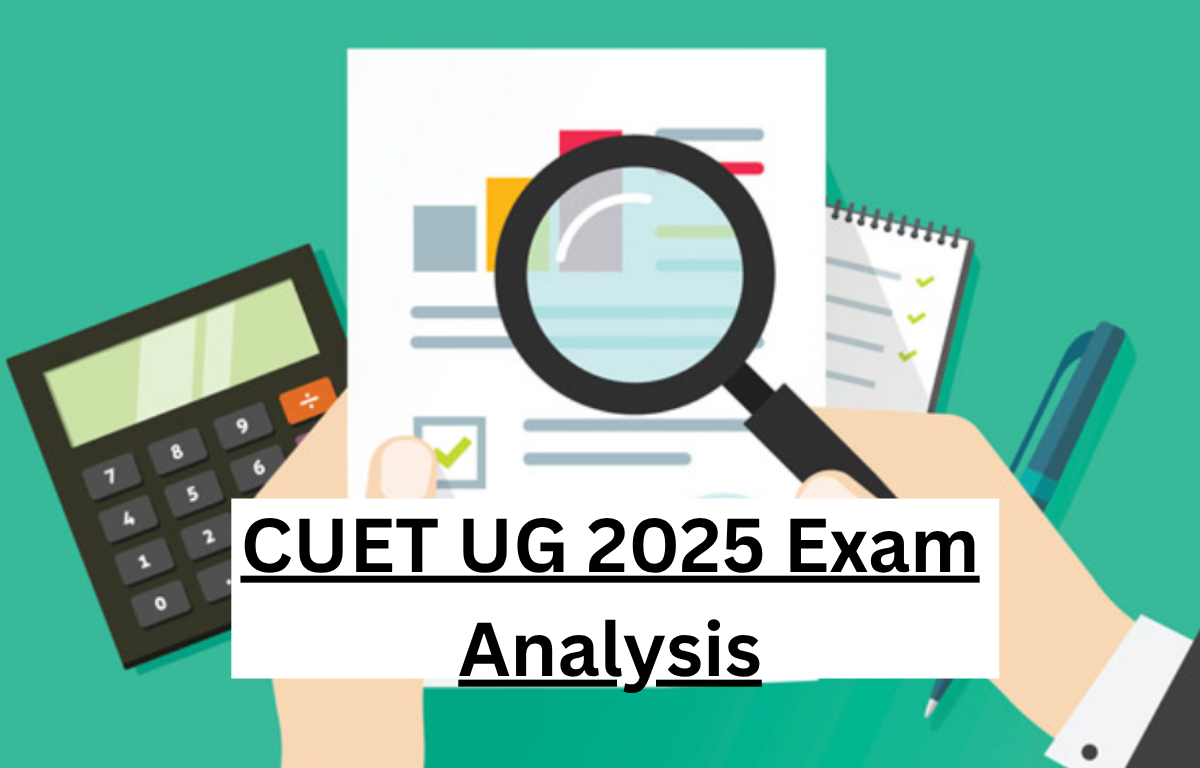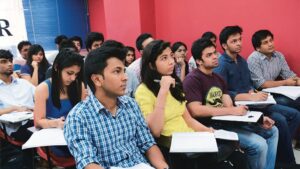The most awaited CUET UG 2025 kicked off today, i.e., May 13, 2025 [Tuesday], at various designated exam centres across the country in two different shifts. The morning shift (Shift 1) was held between 09:00 AM and 12:00 PM, the afternoon shift (second Shift) is being held from 3:00 PM and will last till 6:00 PM. Students who appeared can now check the subject-wise paper analysis and difficulty level based on real-time feedback.
The National Testing Agency (NTA) is conducting CUET 2025 in Computer-Based Test (CBT) mode across India and select international cities. Admit cards for exams scheduled between May 13 and 16 are out now at cuet.nta.nic.in. If your exam is after May 16, stay tuned—your hall ticket will be released soon. This year, CUET UG includes 13 languages, 23 domain-specific subjects, and a General Test.
CUET UG 2025 Exam Analysis
CUET UG 2025 – May 13 Shift 1 is successfully completed! The first shift of the exam was smoothly conducted by NTA across all centres. As per student reactions and expert opinions, the overall difficulty level was pretty balanced and similar to previous trends. The English paper in Shift 1 was rated as moderate—not too tough, not too easy. Want to know how other subjects were? Check the subject-wise difficulty level in the table below! Stay tuned for more updates and insights from the upcoming CUET UG 2025 shifts.
| CUET UG 2025 May 13 Subject-Wise Exam Analysis | |
| CUET Subject | Difficulty Level |
| CUET General Test | Moderate |
| CUET Economics | Easy to Moderate |
| CUET English | Easy to Moderate |
| CUET Physics | Moderate |
| CUET Chemistry | Easy |
| CUET Political Science | Moderate |
CUET UG 2025 May 13 Business Studies Memory-Based Questions and Answers
Q1. Rohan, the sales supervisor of MTS Ltd. is in the process of selecting salesman for his unit.
Arrange the steps, after employment interview, which he would undertake?
(A) Selection Decision
(B) Medical Examination
(C) Job Offer
(D) Contract Of Employment
(E) Reference and background checks
Choose the correct answer from the options given below: 7th June 2023 (Shift 3)
(a) (E), (A), (B), (C), (D)
(b) (E), (B), (C), (A), (D)
(c) (C), (A), (B), (D), (E)
(d) (D), (A), (B), (E), (C)
S1. Ans. (a)
Sol. The Correct Sequence is:
(E) Reference and background checks
(A) Selection Decision
(B) Medical Examination
(C) Job Offer
(D) Contract Of Employment
Q2. Which of the following is not an importance of staffing?
(a) Helps in discovering and obtaining competent personnel
(b) Ensures optimum utilisation of physical resources
(c) Improves job satisfaction and morale
(d) Ensures succession planning for managers
S2. Ans. (b)
Solution. Staffing is primarily concerned with human resources, not physical resources. Ensuring optimum utilisation of human resources (like avoiding overstaffing and understaffing) is a key benefit of staffing. Physical resource management comes under other functions like operations or resource management.
Q3. Which of the following is the correct order of steps a manager must undertake while structuring tasks and creating a formal authority system within an enterprise?
(A) Clarify who reports to whom and who commands whom
(B) Divide the work into specific roles
(C) Allocate duties based on competency
(D) Group similar activities into functional units
(a) B , D , C , A
(b) A , C , D , B
(c) C , A , B , D
(d) D , B , C , A
S3. Ans. (a)
Solution. The correct sequence is:
(B) Identification and division of work
(D) Departmentalisation
(C) Assignment of duties
(A) Establishing authority and reporting relationships
This ensures a logical flow from task recognition to hierarchy establishment.
Q4. A manager at a textile company aims to introduce a new eco-friendly product line. Which of the following steps would he follow to ensure the success of this plan?
(A) Analyse multiple options before choosing the best one
(B) Put the selected plan into action by allocating machinery and labour
(C) Define the targets clearly for all teams involved
(D) Monitor if everything is progressing as scheduled
(E) Base planning on demand forecasts and other assumptions
(a) C, A, B, E, D
(b) A, E, C, D, B
(c) C, E, A, B, D
(d) E, C, B, A, D
S4. Ans. (c)
Solution. The correct sequence is:
(C) Setting objectives
(E) Developing premises
(A) Evaluating alternative courses
(B) Implementing the plan
(D) Follow-up action
Q5. A manufacturing firm notices an increase in product defects. To fix the issue using the control process, which of the following sequences must they follow?
(A) Find out why actual performance differs from expected results
(B) Decide how many defects per batch are acceptable
(C) Take action like retraining staff or modifying standards
(D) Observe and document the real-time output quality
(E) Compare defect rate with what was expected
(a) B, D, E, A, C
(b) D, B, E, A, C
(c) B, D, A, E, C
(d) D, A, B, E, C
S5. Ans. (a)
Solution. The correct sequence is:
(B) Setting performance standards – Decide how many defects per batch are acceptable
(D) Measuring actual performance – Observe and document the real-time output quality
(E) Comparing with standards – Compare defect rate with what was expected
(A) Analysing deviations – Find out why actual performance differs from expected results
(C) Taking corrective action – Take action like retraining staff or modifying standards
Q6. Match the items in List I with the correct description in List II:
| List I (Importance of Controlling) | List II (Descriptions) |
| A. Accomplishing organisational goals | I. Prevents misuse and ensures effective resource utilisation |
| B. Judging accuracy of standards | II. Helps in reviewing benchmarks in changing environment |
| C. Making efficient use of resources | III. Highlights deviations from plans and guides corrective actions |
| D. Improving employee motivation | IV. Informs employees about performance expectations in advance |
Options:
(a) A-I, B-II, C-III, D-IV
(b) A-II, B-I, C-IV, D-III
(c) A-I, B-III, C-II, D-IV
(d) A-III, B-II, C-I, D-IV
Ans. (d)
Solution:
| List I (Importance of Controlling) | List II (Descriptions) |
| A. Accomplishing organisational goals | III. Highlights deviations from plans and guides corrective actions |
| B. Judging accuracy of standards | II. Helps in reviewing benchmarks in changing environment |
| C. Making efficient use of resources | I. Prevents misuse and ensures effective resource utilisation |
| D. Improving employee motivation | IV. Informs employees about performance expectations in advance |
Q7. Match the types of financial decisions in List I with their real-life examples in List II:
| List I (Financial Decisions) | List II (Examples) |
| A. Investment Decision | I. Deciding the proportion of profit to distribute |
| B. Financing Decision | II. Managing day-to-day cash and inventory levels |
| C. Dividend Decision | II. Managing day-to-day cash and inventory levels |
| D. Working Capital Decision | IV. Choosing between issuing equity or debentures |
Options:
(a) A-I, B-II, C-III, D-IV
(b) A-II, B-I, C-IV, D-III
(c) A-III, B-IV, C-I, D-II
(d) A-IV, B-III, C-II, D-I
Ans. (c)
Solution:
| List I (Financial Decisions) | List II (Examples) |
| A. Investment Decision | IV. Choosing between issuing equity or debentures |
| B. Financing Decision | III. Managing day-to-day cash and inventory levels |
| C. Dividend Decision | II. Managing day-to-day cash and inventory levels |
| D. Working Capital Decision | I. Deciding the proportion of profit to distribute |
Q8. Who can be considered a consumer under the Consumer Protection Act, 2019?
(A) A person who buys goods or avails services for personal use by paying or promising consideration.
(B) A person who buys goods for resale or commercial purposes is also a consumer.
(C) A person who avails services through teleshopping, direct selling, or online mode is a consumer.
(D) A person who uses the goods with the approval of the buyer is also treated as a consumer.
Options:
(a) Only A, C, and D
(b) Only A and B
(c) Only B, C, and D
(d) All of the above
Ans. (a)
Solution:
- Statement A – Correct: A consumer is someone who buys goods or services for consideration (paid, promised, or under deferred payment), for personal use.
- Statement B – Incorrect: A person who buys goods for resale or commercial purposes is not considered a consumer.
- Statement C – Correct: The Act covers online, teleshopping, direct selling, and multilevel marketing transactions.
- Statement D – Correct: A user or beneficiary using goods/services with the buyer’s approval is also a consumer.
Q9. Standardisation refers to the process of setting standards for every business activity; it can be standardisation of process, raw material, time, product, machinery, methods or working conditions. This definition of Standardisation was given by:
A) Fayol
(B) Oontz
(C) Taylor
(D) Maslow
Ans. (c)
Solution: The definition of Standardization as setting standards for every business activity, including process, raw material, time, product, machinery, methods, or working conditions, was primarily emphasized by Taylor.
Q10. Which of the following statements correctly describe the significance of Principles of Management?
Statements:
(A) Principles of management help managers make decisions based on personal judgement and instinct rather than logic.
(B) They assist in the optimum utilisation of resources and promote effective administration.
(C) They act as general guidelines that can be adapted to suit changing business environments.
(D) These principles serve as a theoretical foundation for management training, education, and research.
Options:
(a) Only A, B, and D
(b) Only B, C, and D
(c) Only A, C, and D
(d) All of the above
Ans. (b)
Solution:
- Statement A – Incorrect: Principles of management promote scientific and logical decision-making, not based on personal instinct.
- Statement B – Correct: Principles guide managers to use resources efficiently and ensure effective
administration. - Statement C – Correct: The principles are flexible and can be adapted to dynamic environments.
- Statement D – Correct: These principles form the core of management education and research.
Q11. Which of the following is NOT an element of directing?
(a) Delegation of Authority
(b) Motivation
(c) Communication
(d) Leadership
Ans. (a)
Solution: Directing is the management function that involves instructing, guiding, supervising, and inspiring people in the
organization to achieve its objectives. Its key elements are:
- Motivation: Inspiring employees to perform to the best of their abilities.
- Communication: Ensuring clear and effective exchange of information and instructions.
- Leadership: Influencing and guiding employees towards the achievement of goals.
- Delegation of Authority is a crucial element of the Organizing function of management.
Q12. Match the Dimensions of the Business Environment (List I) with their respective descriptions (List II):
| List I (Dimensions) | List II (Descriptions) |
| A. Economic Environment | I. Laws, court decisions, and legal orders |
| B. Political Environment | II. Government stability and policy attitude |
| C. Social Environment | III. Traditions, values, and lifestyles |
| D. Legal Environment | IV. Interest rates, inflation, and GDP |
Options:
(a) A-IV, B-II, C-III, D-I
(b) A-I, B-IV, C-II, D-III
(c) A-III, B-I, C-II, D-IV
(d) A-II, B-III, C-I, D-IV
Ans. (a)
Solution:
| List I (Dimensions) | List II (Descriptions) |
| A. Economic Environment | IV. Interest rates, inflation, and GDP |
| B. Political Environment | II. Government stability and policy attitude |
| C. Social Environment | III. Traditions, values, and lifestyles |
| D. Legal Environment | I. Laws, court decisions, and legal orders |
Q13. Which of the following factors is LEAST likely to be a direct contributor to the development of an individual & entrepreneurial capabilities and mindset?
(a) Family Background
(b) Education
(c) Government Support
(d) Future Certainty
Ans. (d)
Solution: While family background can provide exposure and influence, and government support can offer resources, education directly aims to build entrepreneurial skills and knowledge. Future certainty, on the other hand, is generally not a factor that fosters entrepreneurial development. Entrepreneurship inherently involves navigating uncertainty and ambiguity. A predictable future might even reduce the perceived need for innovation and risk-taking, which are central to entrepreneurship.
Q14. It implies a desire to accomplish something difficult.
(a) Need for Power
(b) Need for Achievement
(c) Need for Affiliation
(d) Need for Autonomy
Ans. (b)
Solution: Need for Achievement implies a desire to accomplish something difficult.
Q15. Which of the following is NOT management in the real sense:
(a) A Finance Manager working to attain profit with the help of his subordinates.
(b) Captain of the Football team discussing strategies to win the match with his team.
(c) A manager of a Restaurant discussing the days menu with his staff
(d) A street hawker selling his goods alone in the market
Ans. (d)
Solution: Management involves coordinating the efforts of others to achieve organizational goals. A street hawker working alone does not engage in management in the true sense, as there is no coordination of efforts or delegation of tasks involved. Management typically involves working with and through people.
Direction (Q16-Q20): Read the passage given below and answer question:
Khanna Ltd. is a company engaged in production and trade of "Phulkari" work of Punjab. Its products are in great demand overseas. The company plans to open one more unit for manufacturing Phulkari products. For this purpose, it requires additional investment of Rs.10 crores. It involves committing the finance on a long-term basis. The Finance Manager of the company has suggested issue of debentures at an estimated cost of 8%. The EBIT of the company was Rs.6,00,000 and total capital invested was Rs.1,00,00,000. The company can also opt for issuing equity shares as an alternative to debt financing. A judicious mix of both sources – Debt and Equity would increase the EPS.
Q16. _____________ decision is exhibited in the above case.
(a) Working Capital
(b) Dividend
(c) Investment
(d) Investment and Financing
Ans. (d)
Solution: The decision to open one more manufacturing unit involves both investment (long-term commitment of funds
for the new unit) and financing (choice between issuing debentures or equity shares). Therefore, it exhibits both
investment and financing decisions.
Q17. A judicious mix of both sources – Debt and Equity would increase the EPS & ___________ concept of Financial Management is conveyed by the above statement.
(a) Risk consideration
(b) Return on Investment
(c) Cost of Equity
(d) Trading on Equity
Ans. (d)
Solution: Trading on Equity is the concept where a company uses a judicious mix of debt and equity to increase its
Earnings Per Share (EPS). By using debt, the company can potentially enhance returns for equity shareholders due to
the tax deductibility of interest, provided the return on investment exceeds the cost of debt.
Q18. “The Finance Manager of the company has suggested issue of debentures at an estimated cost of 8%".
The above statement conveys _____________ type of financial decision.
(a) Working capital decision
(b) Investment decision
(c) Financing decision
(d) Dividend decision
Ans. (c)
Solution: The suggestion to issue debentures at an estimated cost of 8% is a financing decision. It involves choosing the
source of funds (debt financing) to raise the necessary capital for the company & expansion.
Q19. It involves committing the finance on a long-term basis.” _______________ concept of Financial Management is indicated from the above statement.
(a) Capital budgeting decision
(b) Financial leverage
(c) Capital structure decision
(d) Financial risk
Ans. (a)
Solution: Committing finance on a long-term basis indicates a capital budgeting decision. This involves planning and
managing the company & long-term investments and projects, such as opening a new manufacturing unit.
Q20. The decision for opening one more manufacturing unit is related to _____________.
(a) Financing decision
(b) Investment decision
(c) Dividend decision
(d) General decision
Ans. (b)
Solution: The decision to open one more manufacturing unit is an investment decision. It involves committing funds to a
long-term project that is expected to generate future returns for the company.



 Best CUET Coaching in Delhi - Factors De...
Best CUET Coaching in Delhi - Factors De...
 Best CUET Coaching in Noida - Get Top 5 ...
Best CUET Coaching in Noida - Get Top 5 ...
 CUET PG Previous Year Question Papers wi...
CUET PG Previous Year Question Papers wi...







